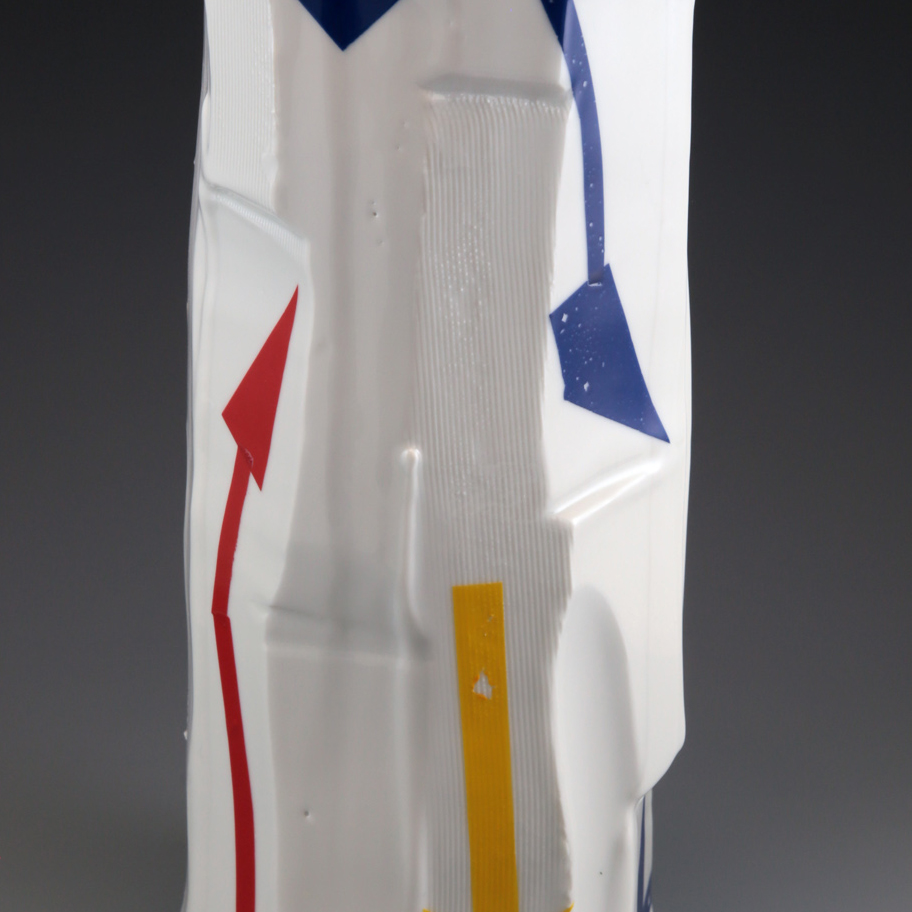Our Pop-Up Shop resident for the month of July is Arnie Zimmerman.
Zimmerman made these works at Eschenbach Porzellan Group – Neue Porzellanfabrik Fabrik in Triptis, Germany. The factory produces restaurant and hotel ware for the German market. However, the owner Rolf Frohwein has over the last 8 years invited groups of artists to create a body of work in the factory. These “artist residencies” are called ‘Spielraum”, meaning “playroom” in English.
Featured Image: Arnie Zimmerman, Polychrome Porcelain Vase, 2014
He was given access to the porcelain and glazes he had access to in the factory. This work made in the factory is in high contrast to the works he usually makes in his studio. Zimmerman created all these works in “Spielraum 122” in summer 2014 and 2015.
I recently asked Zimmerman some questions in an email exchange. Check it out below!

Arnie Zimmerman, Polychrome Porcelain Vase, 2014
CFile: Why do you choose to work with clay?
Zimmerman: The clay chose me to play with. I make up new games all the time so clay doesn’t get bored with me. 43 years and counting clay hasn’t split on me yet. We get along quite well.
C: Sounds like you are totally dedicated to this material. What has clay taught you in 43 years?
Z: How to be an artist.

Arnie Zimmerman, Matte Glazed Porcelain Vase, 2014. Click to purchase!
C: You really enjoyed working in a factory environment while you were at Eschenbach. Were there any disadvantages to the factory setting? Do you find that you crave new environments to make work?
Z: To be the ” artist” in the factory is wonderful, especially when you are there by invitation of the owner. Then you get to play with a lot of material, technology, manpower, as well as feeding off the energy of the factory environment.
I don’t crave new environments to work in. It’s hard enough to find time to work in my own studio. I do enjoy different work settings and when invited I usually go. I’m getting older now and like my creature comforts so I’m less interested in grueling hard work in brick factories or endless wood firing for example.

Arnie Zimmerman, Clear Glazed Porcelain Vase, 2014. Click to purchase!
C: To be the “artist” in the factory is an interesting thing to think about. A factory makes the same thing over and over, while you are creating something new to yourself and to the world at every turn.
How do these vase forms reflect the idea of “Spielraum”?
Z: Spielraum is the German word for playroom. A group of artists were invited to work in a porcelain factory that makes restaurant ware in the former East Germany. The owner, for some wonderful reason, likes to have artists come in and play around with his fine tuned porcelain works. These vases are some of the results of Spielraum 122.
C: The brightly colored lines and stripes are extremely playful. Its apparent you had a good time making this work! Do these surface designs somehow reflect the work being made in the factory? In other words, were you aesthetically inspired by what is manufactured at Eschenbach?
Z: Yes one of the vase forms is a mold taken directly off an extruded section of wet porcelain. These sections are cut up and fed into various shaping machines. Each extruded piece has a date stamped on it. There are also finger marks from who ever handled it in the factory and various other random marks that have been preserved in the casting.
The factory uses decals of solid colors to decorate a line of restaurant ware they call “happy farben” in English “happy colors”. The shapes of the decals are rectangles and round stripes of various widths. I applied this material to the vase forms I created. The precision of the decals were a lot of fun for me and the saturated color was a nice change from my usual palette, it was a rare chance to work with ready made high quality glazes. The other wonderful thing technically is a glaze firing takes only 4 hours. So finished product feed back feels instantaneous for old clay works like myself.

Arnie Zimmerman, Matte Glazed Porcelain, 2016. Click to purchase!


Add your valued opinion to this post.